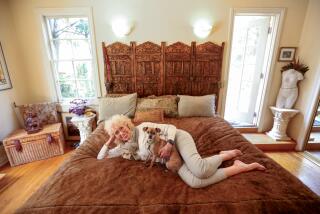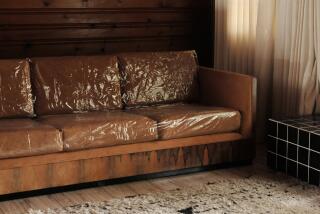Sidelined
The literary evocation of summer is invariably idyllic and unchanging -- the music-box tune of the ice cream truck, the endlessly slamming screen door, the heat you moved through as if it were water, blah, blah, blah. Truly more memorable, and accurate, are the images from the underside of summer -- the teeth-gritting sting of that first post-sunburn shower, the rubbery heat of the canvas inflatable raft, the chemical cloud of freshly lighted briquettes, the lattice-work of red welts on the backs of your parentsâ thighs when they rose from their webbed lawn chairs to get dinner started.
These were the sights and sensations that told you it was really summer.
Yet so many of these things are but memories. Canvas rafts have given way to boogie boards, sunscreen application has become a national art form, sleek gas grills with 17 heat levels and tiled sideboards have replaced the barbecue, and sightings of the webbed lawn chair are few and far between.
In the ongoing luxe-ification of consumer culture, the loss of the web chair is perhaps one of the most poignant. For post-World War II America, this was the chair of summer. Light, portable, colorful, web chairs were to furniture what madras was to the wardrobe -- casual, comfortable and emblematic of a determined attempt to have fun.
Webbed lawn chairs were cold Pabst on the stoop or whiskey sours in the backyard at twilight; they were three generations fanning themselves while they watched the kids play Marco Polo at the community pool; they were block parties and crab feasts and company picnics where the ice cream sandwiches were free. They were plaid incarnate.
Sure, they were difficult to clean and the aluminum frame had a tendency to bend should a less-than-trim family member lean toward the clam dip once too often, but they were perfect for almost every occasion. At the park, at the beach, âround the campfire or just hanging out in the backyard.
Now, of course, all that has changed. Now there is something called the Casual Furniture Market, and it toted up $2.4 billion worth of invoiced shipments in the United States last year, more than double that of 10 years ago. And according to Joe Logan, executive director of the Summer and Casual Furniture Manufacturers Assn., the traditional web chair is no longer part of the picture -- it has dwindled so in popularity and availability that his organization doesnât even track the numbers anymore.
In its place is a hugely diversified and specialized palate of outdoor furniture. For travel needs, portable camp chairs -- the ones that fold up and fit in a bag -- are becoming the No. 1 choice. Some of the newer models come not only with dual cup holders (presumably for two-fisted drinkers) but attached footrests and end tables. A model with a built-in DVD and television screen is no doubt in the works.
At home, this yearâs trend in outdoor furniture is teak, which, Logan says, is replacing the more traditional cedar and redwood and even the migratory Adirondack. The Adirondack, now available in adult and child versions, left its native mountain range several years ago and traveled west, courtesy of Restoration Hardware, Cost Plus and the countless high-end outdoor furniture catalogs that refer, with a completely straight face, to backyards and patios as âopen-air rooms.â
âPeople want and have more options and better quality products,â Logan says. âHigh design is no longer inaccessible, and people are willing to put additional dollars into their patio furniture.â
In fact, the disappearing web chair is just symbolic of a larger trend -- the total backyard renovation. When was the last time you saw a privately owned picnic table? Or a chaise lounge made of those thin plastic straps that also left telltale imprints on the backsides of sunbathers?
In their place are overstuffed cushions, double chaise lounges, a coterie of accessories including lamps, bakersâ racks and cocktail carts, all designed to make the outdoors as sumptuous as the indoors.
âAs homeowners,â says Pat Bowling, director of communications for the American Furniture Manufacturers Assn., âa lot of us decided to make the outdoors an extension of our living space and the manufacturers responded.â Furniture and fabrics that were once reserved for higher-end customers -- restaurants; hotels; really, really rich people -- she says are now available âat every price point.â
Logan attributes this to an increase in imported material -- just as the kitchen remodeling craze has brought down the price of granite and marble, the growth in casual furniture has made teak and mosaics more affordable.
In fact, many of the outdoor trends, from elaborate kitchen models that allow for baking, chilling and barbecuing to granite-topped tables to overstuffed chairs, are simply extensions of earlier indoor trends. Outdoor sofas are now available, and sectionals are probably not far behind.
âItâs a trend toward the outdoor living room,â Logan says.
Which could be construed as mark of maturation. When the old outdoor furniture found its way inside, it was never a good sign -- nothing screams âfirst-time apartmentâ (or occasionally âspouse got the houseâ) more loudly than the presence of a web lawn chair in the living room. So itâs not surprising that as folks hit middle age, they might want the comfort of the Barcalounger in a water-proof version.
Still, there is something so weighty and unfun about real furniture in the backyard. Can you really eat watermelon with impunity on teak? Can kids use it to build a castle during a water hose war? And bringing a camp chair to the beach is a bit like wearing tennis shoes onto the sand -- yeah, you can do it, but it looks pretty weird.
The web chair is not completely extinct; certain varieties are available at some hardware stores and at Target. When asked if there was a chance it might be resurrected as a retro-icon, Bowling laughed. âWell, I donât know. It does seem like everything comes back again sometime, doesnât it?â



